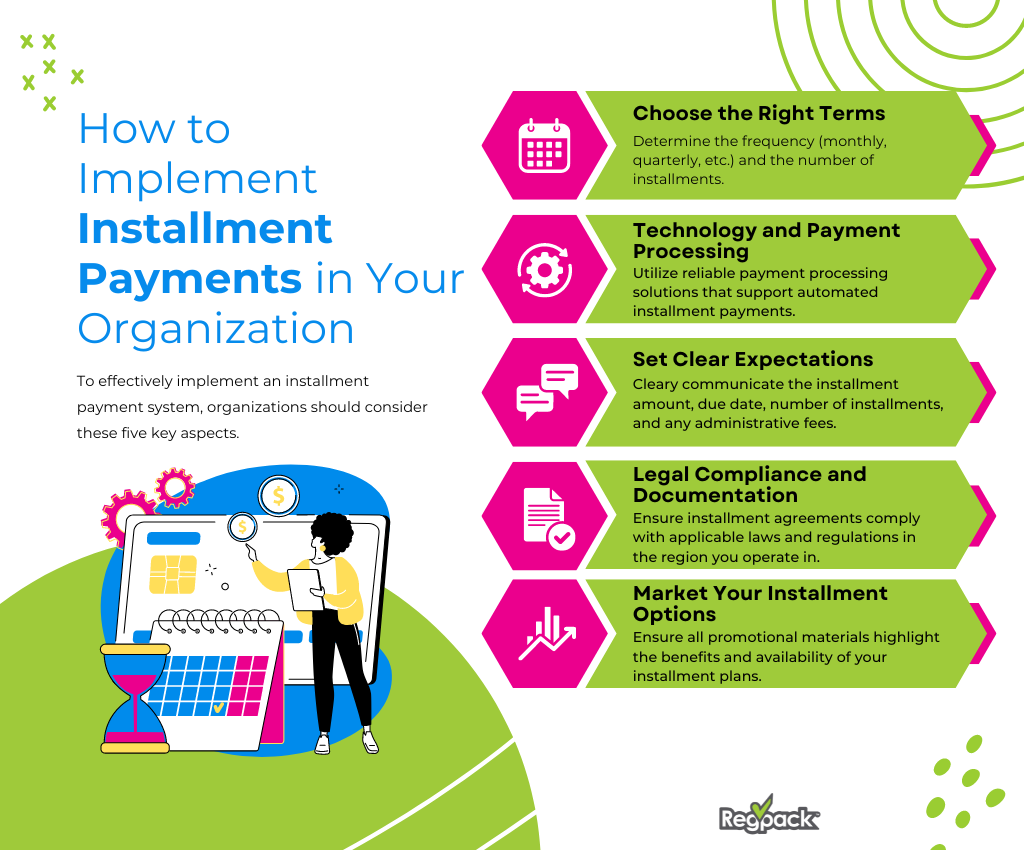In today’s competitive market, organizations are constantly looking for effective strategies to expand and stabilize their financial growth. One strategy that has gained popularity is the use of installment payments.
What are Installment Payments?
An installment payment is a financial arrangement that allows a buyer to pay for goods or services over a period of time through scheduled payments. This method breaks down the total cost of a product or service into smaller, more manageable parts, making purchases more accessible and budget-friendly for customers.
Key Elements of Installment Payments
- Installment Payment Plan: This is a schedule that outlines the number of payments to be made over time to cover the total cost of the item or service. (Ex: monthly payments, bi-weekly payments, etc.)
- Monthly Installment: The specific amount paid each month according to the installment payment agreement.
- Due Date: The payment deadline by which each installment must be paid.
- Initial Payment: The initial payment or first installment is often required at the start of the installment plan, this may be a fraction of the total cost.
Benefits of Implementing Installment Payments
Implementing an installment payment plan can offer several advantages to organizations looking to grow:
Improved Cash Flow
Although it might seem counterintuitive, receiving payments in installments can stabilize cash flow. Predictable, scheduled payments ensure a steady inflow of cash, which can be crucial for maintaining daily operations and planning future expansions.
Increased Sales and Customer Acquisition
Installment payment options can attract a broader customer base, including those who might not be able to make full payments upfront. This is particularly effective in industries where high-cost items are sold, such as electronics, furniture, or educational services.
Reduced Risk of Default
Installment payments spread out the financial commitment for customers, reducing the burden and likelihood of missed payments or defaults.
Greater Customer Loyalty
Providing flexible payment options can improve customer satisfaction and loyalty. Customers are likely to return to a service or provider that accommodates their financial situation and offers manageable payment solutions.
How to Implement Installment Payments in Your Organization

To effectively implement an installment payment system, organizations should consider the following key aspects:
- Choosing the Right Terms: Determine the frequency (monthly, quarterly, etc.), the number of installments, and whether to charge interest or a convenience fee. The terms should balance the organization’s cash flow needs with what the customer can afford.
- Technology and Payment Processing: Utilize reliable payment processing solutions that support automated installment payments, such as direct debit or electronic checks. This ensures timely collections and reduces administrative overhead.
- Set Clear Conditions: Clearly communicate the terms of the installment agreement, including the installment amount, due date, total number of installments, and any additional charges such as late fees or administrative fees. Transparency in these details can prevent misunderstandings and disputes with customers
- Legal Compliance and Documentation: Ensure that the installment agreements comply with applicable laws and regulations in the United States or the specific region you operate in.
- Market Your Installment Options: Marketing your installment payment options can have a significant impact on attracting new customers. Ensure all promotional materials highlight the benefits and availability of your installment plans. This can be effective on websites, in online advertisements, and during the point-of-sale process.
Common Installment Plan Challenges
Implementing installment payment plans offers growth opportunities but also comes with a set of challenges that need careful management.
While installment payments can increase sales, they also introduce the risk of defaults. To mitigate this, conduct thorough credit checks where applicable, and establish a clear policy for handling late payments, including any penalty charges.
Technological integration also poses a significant challenge. Integrating installment payments into your existing financial systems can be a daunting task. It’s advisable to work with IT professionals to ensure seamless integration and to provide a smooth customer experience.
Installment payments can complicate accounting processes. Recognizing revenue and managing receivables become more complex as payments are spread over time. This requires robust accounting systems and possibly more sophisticated financial reporting practices to track incoming payments and manage financial records accurately.
Installment Payment Options
Organizations can choose from various installment payment options tailored to different types of transactions:
- Credit Card Payments: This is ideal for consumer goods and involves customers paying through their credit card over a period, sometimes with no interest.
- Direct Debit Installments: Best for recurring payments such as tuition fees or membership fees, where the amount is directly debited from the customer’s bank account.
- Long-term Payment Plans: Suitable for high-value transactions, offering customers the ability to pay over several years. Examples include mortgage payments, student loans, and automotive financing.
- Payroll Deduction Plans: This option is useful for employee-related expenses. Payments are deducted directly from an employee’s paycheck over a set period, simplifying the transaction process for both the employee and employer. It’s an effective method for items such as company equipment, wellness programs, or even educational courses.
- Online Payment Services: Leveraging third-party payment platforms that facilitate installment payments can enhance convenience and accessibility. These services offer instant approval and integrate directly with an organization’s e-commerce system. Customers can choose to pay in installments at the point of sale, with the service handling the installment management. Popular third-party payment platforms include Afterpay, PayPal Credit, and Klarna.
Each option requires consideration of the payment method, the potential for a down payment (initial payment), and any interest or fees associated with delayed or partial payments.
Special Considerations for Different Sectors
Different sectors might have specific requirements or practices for installment payments:
- Educational Institutions: Schools and universities often offer installment plans for tuition fees and financial aid, typically aligned with the academic year (spring semester, etc.). These payments can be made through student accounts provided by the educational institution.
- Healthcare: Many healthcare providers offer installment agreements to patients for expensive procedures, accommodating varying financial situations.
- Retail and E-commerce: These sectors frequently employ installment payments to encourage higher average order values and repeat customers.
Conclusion
Installment payments are a strategic tool that can significantly contribute to the growth and financial stability of an organization. By making products and services more financially accessible, businesses can expand their customer base and ensure a steady cash flow. Implementing a well-thought-out installment payment system requires careful planning and consideration of the factors discussed above. With the right approach, organizations can harness the power of installment payments to achieve their growth objectives and improve overall financial health.
Regpack Offers Installment Payments Options for your Organization!
Regpacks offers flexible payment installment plans that are fully integrated into their registration system, allowing customers to manage payments directly on their website without the need for third-party processing.
These installment options are designed to accommodate customers with varying budget constraints, providing them with the ability to choose from multiple installment periods such as 3, 6, 9, or 12 payments at checkout.


















